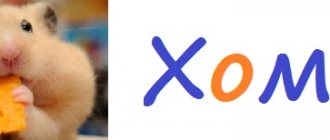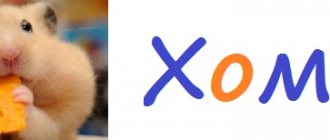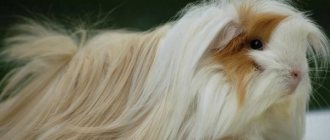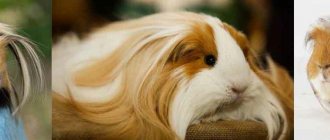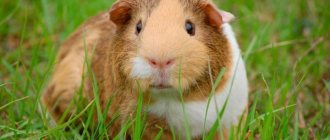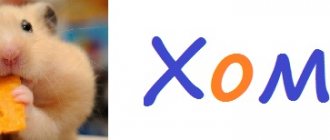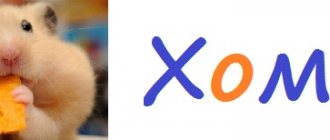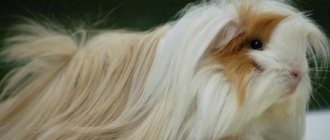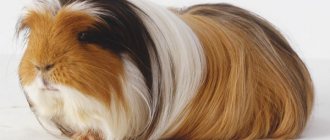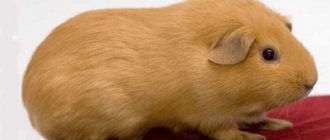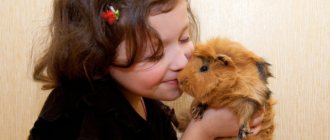Teddy the guinea pig has fluffy fur that makes him look like the famous teddy bear. Thanks to this, the animal received the appropriate name. Teddies are popular as pets due to their peaceful and friendly nature. Information about the characteristics of the breed will help you prepare for possible difficulties in care and maintenance.
Varieties
There are several varieties of Teddy guinea pigs. They differ from each other in the length and structure of their coat. Each type is good in its own way:
- American Teddy. These are the owners of short fur of medium hardness. The ears are almost hairless with drooping tips. The hair on the muzzle is much shorter than on the body.
- Swiss Teddy. This subspecies is distinguished by longer hair, which grows up to 6 cm. The hairs are so hard that they even break under mechanical stress.
- Long-haired Teddy, or Moscow Texel. This variety was created by Russian breeders. Its main difference from others is its smooth, wavy fur, about 15 cm long. The fur on the head and muzzle is shorter than on other parts of the body. An interesting feature of the long-haired Teddy is the presence of luxurious bangs.
You can learn more about guinea pigs in this article.
Differences between Swiss Teddies
Many owners of Swiss Teddy pigs talk about associations with a ball of fluff. This breed is really distinguished by its special long hair, it can reach up to 8 cm. It sometimes stands on end, which looks very funny. On the head area, the hair length is shorter, and in the belly area, slightly curly islands are visible.
There is no consensus among zoologists as to what type the pig should be classified as: some consider it long-haired, others classify it as short-haired.
There are also differences in body structure: a muscular main body and broad shoulders; at the withers the pets reach a respectable size.
You can also distinguish them by the size of their head: it is short and large. Due to the structural features of the head, baby animals cause many problems, both for breeders and for the mother. Complications can begin if the mother pig gives birth for the first time. With age, the feature becomes less noticeable, and the body proportions become more natural.
The nose is even more pointed than other popular breeds. They are distinguished by large and expressive eyes that are set wide apart. Beautiful looking ears that usually hang down like a rabbit's. A number of individuals have characteristic tufts on their ears, which give them an even cuter appearance.
During the development process, Swiss breed types go through several stages of formation of the body coat. After several months of life, molting may begin and the fur may “lay down.” Shedding is observed in two cases: either during a period of danger to health, or during the young period. Molting in a young pig may begin after 1.5 months of age, but then there will be no problems with the animal. The peculiarity is that if there was no shedding in childhood, then despite the general health of the animals, they will be distinguished by scanty fur. A new one grows in place of the fallen one quite quickly, so the process is not so unpleasant for both the animal and the owner.
Additional requirements for the condition of the coat of Swiss Teddy pigs include the following points:
- Ideally, a rodent's fur should consist of so-called “crimped” hairs. Too straight or a large number of curls on the coat will not play into the animal’s favor.
- If in the case of other animals, the hair on end is a sign of an unhealthy pet, then pigs are different here too. A healthy coat of this type should stand on end.
- Ideally, the fur should be the same length. If this is not observed, the animal is unhealthy.
- The main characteristics of fur: density, elasticity, shine. The wool should not be too soft.
- The maximum length of fur is 8 cm, the minimum is 5 cm. Wool shorter than 3.5 cm indicates problems in the body.
- Without rosettes, it should grow in the same direction. There should also be no bald spots.
With proper care and maintenance of the animal, its average life expectancy is from 5 to 8 years.
Description
The American Teddy Guinea Pig is an impressively sized animal. The weight of a mature individual varies from 900 g to 1.4 kg. The body is slightly elongated, stocky, with a well-developed muscle corset.
Teddy pigs have a large head, a wide flattened muzzle and large cheeks. The ears are round in shape and medium in size. There is no wool on them. The tips of the shells are lowered, but do not touch the head; there is a slight wave in the center of the ear. The bridge of the nose is short and wide, the nose is small. Dark, large eyes resemble beads. Rounded shoulders smoothly transition into a body that resembles a barrel.
Coat type and colors
Teddy pigs are a wire-haired variety. The short, elastic fur does not adhere to the body, but grows almost perpendicular to the skin. The length of the fur on different parts of the body is approximately the same. It should not exceed 2 cm, but the shorter the better. If you press the fur with your hand and release it, it will return to its previous position.
Different colors are allowed in the breed:
- white;
- black;
- red;
- brown;
- chocolate;
- cream;
- brindle;
- agouti – silver and golden.
We also recommend an article about guinea pigs with white coat color.
Two-colored teddy pigs, as well as pets with a tortoiseshell color, are very popular.
Exterior defects
At exhibitions, commission members evaluate whether the pig’s appearance meets the standard requirements. Disqualification for the following deviations:
- insufficiently elastic hair;
- wool length exceeds 2 cm;
- straight hairs in the abdominal area;
- the absence of one shade of fur on the right or left side in tri-colored pigs.
History of the breed
This species of rather large domestic rodents appeared as a result of a natural mutation. For the first time they were noticed by Canadian breeders, who began propagating the subspecies. This happened in the late 60s of the last century. A few years later, namely in 1978, the breed received official recognition, description and nomenclature.
The name of the breed is directly related to its appearance: the wavy, hard coat and the “figure” itself are more reminiscent of the Teddy bear toy, so popular among American children, than of a small and inconspicuous pig.
These rodents were brought to the territory of the post-Soviet space relatively recently, but in a short time they managed to win the hearts of pet lovers.
Character and behavior
The American Teddy is a guinea pig that is not known for aggression. Cases where representatives of this breed bite or scratch their owner are very rare. This can only happen in a situation where the pig is very scared or in pain.
The pet is moderately active, loves to play and explore the world around him, although he seems clumsy and clumsy. Teddy Pig loves to be the center of attention and interact with people. If the pet doesn’t want to play, it will simply push away the owner’s hand with its head or paw. This is how he shows his dissatisfaction. Teddy pig reacts calmly to the presence of other animals in the house.
The animal likes to receive affection. Representatives of this breed love to have their belly rubbed. They set him up on purpose - this is how pets demonstrate absolute trust. This makes Teddies different from other rodents. If desired, the pig can be trained to perform simple tricks.
Advantages
However, these animals have other advantages:
- Good-natured and peaceful disposition. Even if the animal is irritated, it will not bite, it will only poke your hand with its muzzle. For this reason, even small children can play with them.
- They are sociable pets and get along well with other pets (cats and small rodents - mice, for example).
- The physique is large, while the animals are mobile and happily walk outside the cage. They lead a diurnal lifestyle and sleep at night, snoring peacefully.
- Teddy pigs stand out among their fellow pigs for their cleanliness; a cage with rodents will not be a source of unpleasant odor in the house.
- The short coat of these pets does not require daily brushing, and as a result, caring for them is not tiring.
Health and life expectancy
Teddy guinea pigs are not long-lived. The average life expectancy is 5-6 years. The maximum is 8 years. The health of a pet directly depends on the living conditions and quality of food.
Like other breeds, Teddy pigs often suffer from respiratory diseases, conjunctivitis, and parasitic diseases. Errors in nutrition can cause indigestion. The absence of roughage in the diet leads to excessive growth of teeth, which causes inflammatory processes in the oral cavity.
But the greatest danger to a Teddy pig is infectious diseases, due to which it can die in a matter of days:
- plague;
- pasteurellosis;
- pseudotuberculosis.
Teddy Guinea Pig
Teddy guinea pigs are very similar to small teddy bears and, thanks to this similarity, are considered one of the most beautiful pet rodents in the whole world! And not only beautiful, but also cheerful, because teddies are very sociable, affectionate and playful. Watching them is a pleasure!
Description
The Teddy guinea pig is very similar to a teddy bear, and it is this similarity that gives it its name. Teddy's fur is short (no more than 2 cm), hard and very thick, it fluffs up and never wrinkles.
Thanks to their fluffy, slightly curly fur, Teddies look round and plump and are considered one of the most beautiful breeds of guinea pigs.
Another feature of the breed is the so-called Greek nose (with a small hump). Teddy's eyes are large, expressive and bright. The ears are large and hanging.
The color of guinea pigs can be very diverse: both solid and variegated. The most common are teddies with a single color, two-color teddies (a combination of white with any other color), agouti, etc.
Future Teddy owners need to understand that the pet's fur may not always look plush and neat. For example, teenagers' hair often becomes silky and it seems as if it is losing its curliness. But don’t worry, this phenomenon is temporary, and very soon the fur will regain its valuable qualities.
Behavior
Yes, teddies look a lot like clumsy teddy bears, but don't let the resemblance fool you. In fact, teddies are incredibly active and energetic. They overcome obstacles with amazing dexterity, run quickly, and love to play. When handled correctly, rodents have a calm, peaceful and friendly character. Teddies do not bite (although their teeth should not be underestimated), and if dissatisfied, they can angrily poke their muzzle into your hand.
Lifespan
Life expectancy with proper care is 6-8 years.
Content Features
Teddies are unpretentious, and care for them is standard, as for other breeds of guinea pigs. Only the fur and skin of the rodent requires special attention. To maintain the health and beauty of their coat, pets periodically need trimming. The coat should be combed at least 2 times a week: first in the direction of hair growth, then against it, and then again in the direction. This method of combing allows you to saturate the fur with oxygen.
The teddy's skin is prone to dryness, so the rodent's diet should include wheat germ, sunflower seeds and oats.
Story
America is the birthplace of plush guinea pigs. The first representative of the breed was born as a result of a peculiar mutation in 1968. And only 10 years later, through the efforts of breeders, the “Teddy” breed was recognized. The new guinea pigs immediately became incredibly popular in their own country, but they appeared in Russia not so long ago, just a few years ago. Today they are very popular and sought-after pets - and, according to many, the most beautiful guinea pigs in the world.
Source
Features of feeding
Teddy guinea pig eats exclusively plant foods. Animal feed is contraindicated for her. The basis of a rodent's diet is hay.
Rough food promotes normal digestion and helps wear down teeth. Therefore, in addition to dried grass, pigs are given twigs of fruit trees and shrubs to chew on - cherries, apricots, currants.
What else can you give your teddy pig:
- vegetables - carrots, broccoli, celery, zucchini, cabbage;
- fruits – apples, pears, melon;
- fresh greens - dandelion leaves, plantain, nettle, clover;
- grain sprouts;
- pumpkin seeds and sunflower seeds.
Attention! The guinea pig's body does not produce vitamin C; the pet can only get it from food. Therefore, vegetables, fruits and herbs must be included in the teddy's diet.
Owner reviews
Maksim
We bought a couple of Teddies for our daughter six months ago, both females. Interesting color: one is white and brown, the other is beige and black. Contrary to expectations, they did not bring any problems to our family. Only positive emotions. Today, my wife and I don’t even know who is more happy about these pigs: us or our child. When we come home from work, the animals greet us with a joyful squeal and rush towards us if our daughter lets them roam around the apartment. Amazing animals that changed my attitude towards rodents.
Tatiana
My pig Logan is one and a half years old. This is a Swiss Teddy with a long, hard and thick coat. It seems to me that I have never met a more affectionate animal. Loves to kiss and constantly asks to be held. I try not to buy ready-made food. My mother supplies me with greens from her garden. I make the hay myself. I pick up sedge from a nearby forest plantation and dry it on paper spread at the top of the kitchen cabinet. Additionally, I buy oats, pearl barley and sunflower seeds. Sometimes I cook millet or rice porridge for my pet. He eats fruits and vegetables with me; we are vegetarians. Logan is active, obedient, sleeps at night, plays or watches me during the day. The only problem is when I'm late at work. It happened that the animal refused to eat the next day. I'm thinking about buying him a girlfriend.
Pros and cons of content
Before you decide to get a Teddy pig, you should weigh everything. The table shows the advantages and disadvantages of the pet.
| pros | Minuses |
| Easy to care for | Skin problems |
| Friendly character, lack of aggression | Short life expectancy |
| Cleanliness | May cause allergies in humans |
| Teddy pig is smart and trainable | Teddy pig squeaks loudly when he's hungry |
| Ability to get along with other animals |
Breeding
When breeding Teddy pigs, you must be very careful when choosing a partner for mating. First of all, attention should be paid to the structure of the coat, and only then to the color and physique.
When choosing a breeding sire, make sure that the coat is hard and uniform. There should be no bald spots or rosettes on the sides, stomach and neck. Another important point is that it is advisable to cross a male and a female, which have different muzzles - blunt and elongated.
Puberty in Teddy pigs occurs at two months of age, but it is too early to breed them at this time. The suitable age for bearing healthy offspring is 8 months. The female's estrus occurs every 14-18 days and lasts on average 1-2 days. The most favorable time for fertilization is the first 6-8 hours after the start of estrus.
Pregnancy lasts 60-72 days. A Teddy pig can bear 2 to 4 babies. The first birth lasts 4-6 hours, and subsequent labor lasts 60-70 minutes. There are usually no complications. Piglets are born weighing 55-140 g. The mother's milk is very fatty, so the cubs experience intensive growth. The weight of small pigs doubles at two weeks of age.
Interesting fact. Newborn pigs have fully formed incisors, babies see and distinguish sounds. The development of hearing and vision is completed in the womb. Already on the second day of life they show interest in the feeder from which the mother eats.
The American Teddy Guinea Pig will be a wonderful friend for a family with children or a lonely elderly person. Such a pet does not require large financial expenditures; it only needs a little attention, love and care.
Care
The pig needs to be brushed
The American guinea pig is easy to care for. It is enough to provide her with proper nutrition, a clean home and regularly brush her fur.
Housing requirements
Active and moderately large American Teddies need a spacious metal cage or terrarium where they can frolic all day.
You can add special filler, sawdust or straw to the bottom of the cage. The cage needs to be cleaned 1-3 times a week.
Guinea pigs are sensitive to cold, so beware of drafts, but placing the cage near radiators is also not recommended.
In summer, you can take the animals with you outside and walk them on the green grass. Walking is only permissible in warm and dry weather; rain and wind can cause colds in animals.
Nutrition
The main source of food for pigs is hay. It must be in the cage at all times. Hay normalizes the functioning of the digestive system, thanks to it the teeth are properly worn down.
The second important part of the diet is juicy vegetables and roots. It is recommended to give pigs carrots, beets, apples, celery roots, and cherry twigs. These products are a source of vitamin C for animals, which their bodies cannot produce on their own.
You can give sprouted grains: wheat, oats, corn or peas.
Animals need to have a container of clean water for drinking and change it every few days.
What not to feed
Improper nutrition can cause digestive disorders and even lead to the death of the animal.
Teddy guinea pigs are herbivores, so you should not feed them animal products. The same applies to milk.
Sweet fruits should not be fed to your pets often; it is better to treat them as treats.
Grooming
To maintain the health of your pet, it is necessary to comb out the fur regularly, at least once a week, and trim at least once a month. This simple procedure, in other words plucking, can be done independently or in a salon by a specialist.
You should not bathe your guinea pig unnecessarily unless its fur is very dirty. Bathing should be done in warm water, and then gently dry the animal with a towel.
GUINEA PIGS AMERICAN TEDDY
American Teddy guinea pig.
Guinea pig American Teddy. Nursery "Rodenta"
guinea pig breakfast
Guinea pigs. Features of care and maintenance. Give Paw
